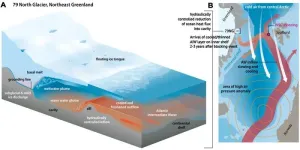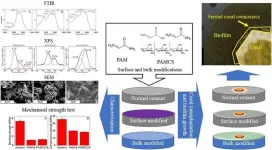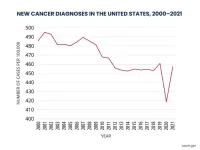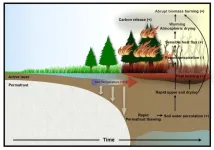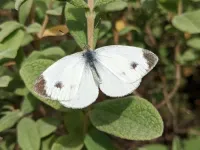(Press-News.org) Northeast Greenland is home to the 79° N Glacier – the country’s largest floating glacier tongue, but also one seriously threatened by global warming: warm water from the Atlantic is melting it from below. Experts from the Alfred Wegener Institute have however now determined that the temperature of the water flowing into the glacier cavern declined from 2018 to 2021, even though the ocean has steadily warmed in the region over the past several decades. This could be due to temporarily changed atmospheric circulation patterns. In a study just released in the journal Science, the researchers discuss how this affects the ocean and what it could mean for the future of Greenland’s glaciers.
Over the past few decades, the Greenland Ice Sheet has lost more and more mass, which has also lessened its stability. This is chiefly due to the warming of the atmosphere and oceans, which accelerates the melting of ice, contributing in turn to an increase in mean sea level. The Northeast Greenland Ice Stream alone, which feeds into the massive Nioghalvfjerdsfjorden Glacier – also known as the 79° N Glacier – could produce a metre of sea-level rise if it melted completely. Beneath the glacier tongue lies a cavern that ocean water flows into. Data gathered by the Alfred Wegener Institute, Helmholtz Centre for Polar and Marine Research (AWI) now indicates that the temperature of the water flowing into the cavern declined between 2018 and 2021. “We were surprised to discover this abrupt cooling, which is a marked contrast to the long-term regional ocean warming we’ve observed in the influx to the glacier,” says Dr Rebecca McPherson, a researcher at the AWI and the study’s first author. “Since the ocean water in the glacier cavern grew colder, it means less oceanic warmth was transported under the ice in this period – and in turn, the glacier melted more slowly.”
But where did this cold water below the glacier come from if temperatures in the surrounding ocean continued to climb? To find out, the AWI researchers collected data from 2016 to 2021, using an oceanographic mooring to do so. The monitoring platform continually took readings on parameters like the temperature and flow speed of the seawater at the calving front of the 79° N Glacier, which is where water flows into the cavern. Whereas the temperature of the Atlantic water initially rose, topping out at 2.1 degrees Celsius in December 2017, it dropped by 0.65 degree again from early 2018.
“We were able to track down the source of this temporary cooling from 2018 to 2021 upstream, to Fram Strait and the vast Norwegian Sea,” Rebecca McPherson explains. “In other words, circulation changes in these remote waters can directly affect the melting of the 79° N Glacier.” As such, the lower water temperatures in Fram Strait were the result of atmospheric blocking. When this blocking occurs, stationary high-pressure systems in the atmosphere force the normally dominant air currents to deviate. That’s also what happened over Fram Strait: several atmospheric blocks over Europe allowed more cold air from the Arctic to flow through Fram Strait into the Norwegian Sea. This slowed water from the Atlantic that was flowing toward the Arctic, so that it cooled more than usual along the way. The cooled water then flowed through Fram Strait to Greenland’s continental shelf and the 79° N Glacier. The whole process – from the appearance of the atmospheric blocks to the inflow of the cooler Atlantic water in the glacier cavern – took two to three years.
“We assume that atmospheric blocks will remain an important factor for multiyear cooling phases in the Norwegian Sea,” says Rebecca McPherson. “They provide the atmospheric and oceanic conditions that influence temperature variability in Atlantic Ocean water, and in turn the glaciers of Northeast Greenland.” Why? Because the northward-flowing water mass not only continues farther into the Arctic, where it affects the extent and thickness of sea ice; in Fram Strait, roughly half of the water veers to the west, where it determines the oceanic melting of Greenland’s glaciers. “In the summer of 2025, we’ll be returning to the 79° N Glacier on board the research icebreaker Polarstern. We already know that water temperatures in Fram Strait are now rising again slightly and we’re anxious to see if the glacier melting increases as a result.”
To more accurately predict the fate of the 79° N Glacier, it’s important to understand what is driving changes within it, as Rebecca McPherson stresses: “Our study offers new insights into the behaviour of Northeast Greenland’s glaciers in a changing climate. This will allow forecasts for rising sea levels to be refined.” As their colleague Prof Torsten Kanzow from the AWI adds: “Generally speaking, we consider the warm-water inflow into the cavern below the 79° N Glacier to be part of the Atlantic Meridional Overturning Circulation (AMOC). Forecasts indicate that this thermal conveyor belt could weaken in the future. One key challenge will be to establish long-term observation systems capable of capturing the effects of macro-scale ocean circulation extending as far as the fjords of Greenland.”
END
Atmospheric blocking slows ocean-driven melting of Greenland’s largest glacier tongue
Processes in the atmosphere are cooling the Atlantic seawater flowing into the ice cavern beneath Northeast Greenland’s 79° N Glacier
2024-09-24
ELSE PRESS RELEASES FROM THIS DATE:
Improved cement to protect the living treasures of our coastlines
2024-09-24
WASHINGTON, Sept. 24, 2024 – Coastlines are vital to our world’s ecology and economy. Coastal ecosystems help maintain biodiversity, provide natural barriers against erosion, storms, and flooding, and act as large carbon sinks to reduce greenhouse gases. Sustainable fisheries and seaside tourist venues support local economies.
Natural coastlines, including coral reefs, marshes, and mangroves, are complete and stable, capable of self-regulation and restoration. That is, unless human interventions, such as urbanization, overdevelopment, pollution, and human-made erosion, make these areas vulnerable to devastation.
Artificial coastlines, ...
Absolute and functional iron deficiency in the US
2024-09-24
About The Study: The findings of this study suggest that absolute and functional iron deficiency affect a large proportion of American adults even in the absence of anemia, heart failure, or chronic kidney disease. Further research on the role of functional iron deficiency in adverse health outcomes and on iron deficiency screening strategies is needed.
Corresponding author: To contact the corresponding author, Leo F. Buckley, Pharm.D., M.P.H., email lfbuckley@bwh.harvard.edu.
To access the embargoed ...
Rural-urban disparities in hospital services and outcomes for children with medical complexity
2024-09-24
About The Study: Rural-residing children with medical complexity were significantly more likely to present to hospitals without dedicated pediatric services in this cohort study. These findings suggest that efforts are justified to ensure that all hospital types are prepared to care for children with medical complexity.
Corresponding author: To contact the corresponding author, JoAnna K. Leyenaar, M.D., Ph.D., M.P.H., email joanna.k.leyenaar@hitchcock.org.
To access the embargoed study: Visit our For The Media website at this link https://media.jamanetwork.com/
(doi: 10.1001/jamanetworkopen.2024.35187)
Editor’s Note: Please ...
Fewer than half of US jails provide life-saving medications for opioid use disorder
2024-09-24
A new look into addiction treatment availability in the U.S. criminal justice system reveals that fewer than half (43.8%) of 1,028 jails surveyed across the nation offered any form of medication for opioid use disorder, and only 12.8% made these available to anyone with the disorder. With two-thirds of people who are incarcerated in U.S. jails experiencing a substance use disorder – in many cases, an opioid use disorder – the failure to make these medications widely available in criminal justice settings represents a significant missed opportunity to provide life-saving treatments in an environment where people in need of care can be easily reached.
The study, published ...
Voice-activated cognitive behavioral therapy for insomnia
2024-09-24
About The Study: This randomized clinical trial of an in-home, voice-activated cognitive behavioral therapy for insomnia program among breast cancer survivors found that the intervention improved insomnia symptoms. Future studies may explore how this program can be taken to scale and integrated into ambulatory care.
Corresponding author: To contact the corresponding author, Hannah Arem, Ph.D., email Hannah.Arem@medstar.net.
To access the embargoed study: Visit our For The Media website at this link https://media.jamanetwork.com/
(doi: ...
New cancer diagnoses did not rebound as expected following pandemic
2024-09-24
What: Cancer incidence trends in 2021 largely returned to what they were before the COVID-19 pandemic, according to a study by researchers at the National Institutes of Health (NIH). However, there was little evidence of a rebound in incidence that would account for the decline in diagnoses in 2020, when screening and other medical care was disrupted. One exception was breast cancer, where the researchers did see an uptick in diagnoses of advanced-stage disease in 2021. The study appears Sept. 24, 2024, in the Journal of the National Cancer Institute.
A previous study showed that new cancer diagnoses fell abruptly ...
Abrupt intensification of northern wildfires due to future permafrost thawing
2024-09-24
A study, published in the journal Nature Communications by an international team of climate scientists and permafrost experts shows that, according to new climate computer model simulations, global warming will accelerate permafrost thawing and as a result lead to an abrupt intensification of wildfires in the Subarctic and Arctic regions of northern Canada and Siberia.
Recent observational trends suggest that warm and unusually dry conditions have already intensified wildfires in the Arctic region. To understand ...
Review shows bird flu control strategies ‘not working’
2024-09-24
A review of sustained mammal-to-mammal bird flu transmission in diverse species, led by The Pirbright Institute, shows global control strategies are not working.
Writing in Nature, researchers analysed whether outbreaks in European fur farms, South American marine mammals and United States dairy cattle raise questions about whether humans are next. Led by zoonotic influenza specialist Dr Thomas Peacock, the scientists evaluated how recent changes in the ecology and molecular evolution of H5N1 in wild and domestic birds increase opportunities for spillover ...
How a butterfly invasion minimizes genetic diversity
2024-09-24
Until a few years ago, the butterfly known as the southern small white could barely be found north of the Alps. That was before a Europe-wide invasion that brought a huge increase in the insect’s distribution – at the same time as a rapid decrease in genetic diversity within the species.
It took a while for zoologist Daniel Berner to notice that a butterfly species that wasn’t local to his area had become established in his garden. Then, suddenly, he saw it everywhere: Pieris mannii – also known as the southern small ...
Another Franklin expedition crew member has been identified
2024-09-24
The skeletal remains of a senior officer of Sir John Franklin's 1845 Northwest Passage expedition have been identified by researchers from the University of Waterloo and Lakehead University using DNA and genealogical analyses.
In April of 1848 James Fitzjames of HMS Erebus helped lead 105 survivors from their ice-trapped ships in an attempt to escape the Arctic. None would survive. Since the mid-19th century, remains of dozens of them have been found around King William Island, Nunavut.
The identification was made possible by a DNA sample from a living descendant, which matched the ...
LAST 30 PRESS RELEASES:
Tracing the quick synthesis of an industrially important catalyst
New software sheds light on cancer’s hidden genetic networks
UT Health San Antonio awarded $3 million in CPRIT grants to bolster cancer research and prevention efforts in South Texas
Third symposium spotlights global challenge of new contaminants in China’s fight against pollution
From straw to soil harmony: International team reveals how biochar supercharges carbon-smart farming
Myeloma: How AI is redrawing the map of cancer care
Manhattan E. Charurat, Ph.D., MHS invested as the Homer and Martha Gudelsky Distinguished Professor in Medicine at the University of Maryland School of Medicine
Insilico Medicine’s Pharma.AI Q4 Winter Launch Recap: Revolutionizing drug discovery with cutting-edge AI innovations, accelerating the path to pharmaceutical superintelligence
Nanoplastics have diet-dependent impacts on digestive system health
Brain neuron death occurs throughout life and increases with age, a natural human protein drug may halt neuron death in Alzheimer’s disease
SPIE and CLP announce the recipients of the 2025 Advanced Photonics Young Innovator Award
Lessons from the Caldor Fire’s Christmas Valley ‘Miracle’
Ant societies rose by trading individual protection for collective power
Research reveals how ancient viral DNA shapes early embryonic development
A molecular gatekeeper that controls protein synthesis
New ‘cloaking device’ concept to shield sensitive tech from magnetic fields
Researchers show impact of mountain building and climate change on alpine biodiversity
Study models the transition from Neanderthals to modern humans in Europe
University of Phoenix College of Doctoral Studies releases white paper on AI-driven skilling to reduce burnout and restore worker autonomy
AIs fail at the game of visual “telephone”
The levers for a sustainable food system
Potential changes in US homelessness by ending federal support for housing first programs
Vulnerability of large language models to prompt injection when providing medical advice
Researchers develop new system for high-energy-density, long-life, multi-electron transfer bromine-based flow batteries
Ending federal support for housing first programs could increase U.S. homelessness by 5% in one year, new JAMA study finds
New research uncovers molecular ‘safety switch’ shielding cancers from immune attack
Bacteria resisting viral infection can still sink carbon to ocean floor
Younger biological age may increase depression risk in older women during COVID-19
Bharat Innovates 2026 National Basecamp Showcases India’s Most Promising Deep-Tech Ventures
Here’s what determines whether your income level rises or falls
[Press-News.org] Atmospheric blocking slows ocean-driven melting of Greenland’s largest glacier tongueProcesses in the atmosphere are cooling the Atlantic seawater flowing into the ice cavern beneath Northeast Greenland’s 79° N Glacier
